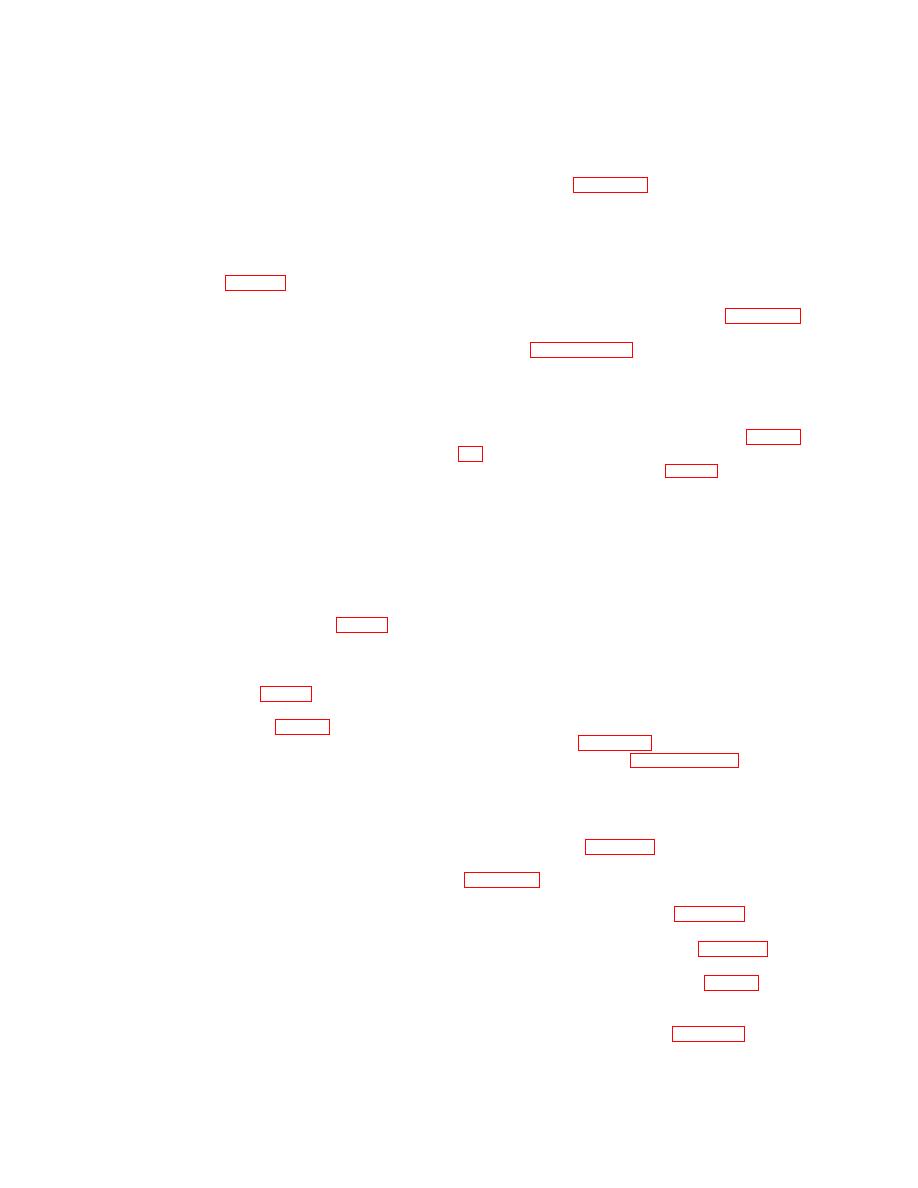
TM 5-4930-218-14
the diverter valve with solvent and dry thoroughly.
fails to operate properly.
(2) Inspect the asbestos coverings for fraying,
(4) Inspect the flexible tubing and the adapters
abrasions, and deterioration. Replace if damaged.
for cracks, holes, severe corrosion, and other damage.
(3) Inspect the diverter valve for cracks, severe
Replace defective parts.
rust or corrosion, and broken adapter pipes. Check for
c. Installation. Installation is the reverse of
rough or restricted operation of the diverter valve
removal. Refer to figure 4-6.
handle. Replace the valve if it is damaged or if it
Section XIII. ENGINE AND DRIVE
4-35. General
place. Severe injury to operating per-
sonnel could result.
c. Installation. Installation of the drive belts and
welded engine base (5) which is secured to a mount-
guard is the reverse of removal. Refer to figures 4-4
ing pad on top of the air reservoir, It is positioned
and 4-9. Note that you should adjust belt tension as
beside the air compressor to facilitate the power
directed in paragraph 3-11b before installing the belt
transfer. The engine drives the compressor through a
guard.
set of matched drive belts. The belts are protected by
a guard (2) to prevent personnel injury and to
prevent materials from getting caught between the
pulleys and belts. Belt tension is adjusted by varying
a. Removal.
the position of the engine. An adjusting bolt (7)
(1) Remove the drive belts and guard (para 4-
mounted on the mounting pad facilitates moving the
engine to loosen or tighten the belt.
(2) Loosen the setscrew (77, fig. 4-4) and pull the
b. The drive pulley is mounted on the drive end of
groove pulley (78) from the adapter shaft (82) on the
the engine crankshaft. An adapter, bolted to the
engine crankshaft. Remove the key (79).
crankshaft, mounts the pulley. The engine pulley is
(3) Remove the cap screws (80) and lock washers
smaller than the compressor pulley to provide the
(81) that secure the adapter shaft to the crankshaft;
required speed reduction between the components.
remove the adapter shaft.
b. Cleaning and Inspection.
(1) Clean the groove pulley and adapter shaft
with dry cleaning solvent (fed. spec. P-D-680). Dry
a. Removal.
thoroughly.
(1) Remove the cap screws (1 and 2, fig. 4-9), nuts
(2) Inspect the groove pulley and adapter shaft
(3), lock washers (4), and flat washers (5) that secure
for cracks, chips, and distortion. Inspect the grooves
the drive belt guard (6) to the engine and compressor
of the pulley for roughness, wear, burrs, and other
(22); remove the guard.
damage. Remove minor burrs with a fine stone.
(2) Loosen the nuts (84, fig. 4-4) on the cap screws
Replace a damaged pulley or shaft.
(83) that lock the engine base (87) to the mounting
c. Installation. Installation is the reverse of
pad on the air reservoir (36, fig. 4-9).
removal. Refer to figure 4-4. Install the drive belt
(3) Loosen adjusting bolt (7) and push engine
guard and drive belts per paragraph 4-26c.
toward the air compressor to relieve tension on the
drive belt set (9); remove the drive belts.
4-38. Engine
b. Cleaning and lnspection.
(1) Wipe the drive belts with a dry cloth. Clean
a. Removal.
the belt guard with a cloth dampened with dry
(1) Remove the enclosure from the lubricating
cleaning solvent (fed. spec. P-D-680).
and servicing unit (para 4-17a).
(2) Inspect the drive belts for cracks, wear,
(2) Disconnect fuel lines to the engine fuel pump
fraying, glazing, brittleness, and deterioration. If
either belt is damaged, both must be replaced as a
(3) Disconnect the throttle control and choke con-
trol from the engine carburetor (para 4-30).
matched set. Do not replace belts singly.
(3) Inspect the belt guard for cracks, broken
(4) Tag and disconnect the electrical lead to the
oil temperature sensor on the engine (para 4-26) and
weldments, distortion, severe dents, or any other
damage that could impair its effectiveness. Replace a
remove the sensor. Remove the control panel and
damaged belt guard.
remove the control panel bracket (24, fig. 4-5) from
the engine flywheel housing.
WARNING
Do not operate the engine and com-
(5) Remove the exhaust diverter valve and
exhaust piping from the engine (para 4-34).
pressor without the belt guard in


